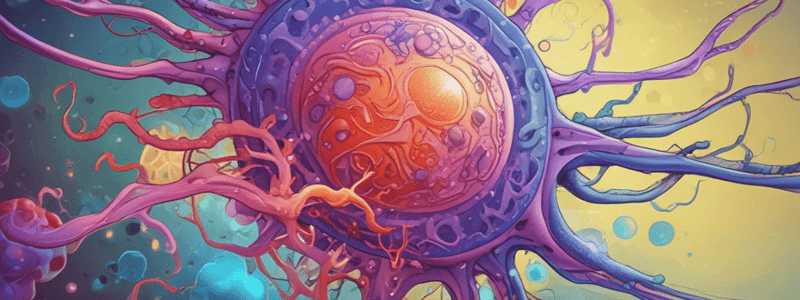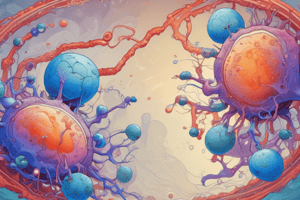Podcast
Questions and Answers
What is the primary function of APCs in the generation of a useful cell-mediated immune response?
What is the primary function of APCs in the generation of a useful cell-mediated immune response?
- To produce costimulators
- To capture and concentrate antigens in specialized lymphoid organs (correct)
- To activate T cells directly
- To recognize and respond to microbial antigens
Which type of T cells respond to antigens from the endosomal compartment?
Which type of T cells respond to antigens from the endosomal compartment?
- Naive T cells
- CD8+ CTLs
- APCs
- CD4+ helper T cells (correct)
What determines the selectivity of T cells responding to antigens from the endosomal and cytosolic compartments?
What determines the selectivity of T cells responding to antigens from the endosomal and cytosolic compartments?
- The type of antigen presented
- The location of the antigen in the lymphoid organ
- The expression of costimulators on APCs
- The specificity of the CD4 and CD8 coreceptors for class II and class I MHC molecules (correct)
What is the reason for T cells to respond to microbial antigens but not to harmless proteins?
What is the reason for T cells to respond to microbial antigens but not to harmless proteins?
What is the primary function of costimulators in the immune response?
What is the primary function of costimulators in the immune response?
What is the mechanism by which T cells recognize antigens from the cytosolic compartment?
What is the mechanism by which T cells recognize antigens from the cytosolic compartment?
What is the purpose of the segregation of extracellular and intracellular protein antigens for display by class II and class I MHC molecules?
What is the purpose of the segregation of extracellular and intracellular protein antigens for display by class II and class I MHC molecules?
What is the role of naive T cells in the immune response?
What is the role of naive T cells in the immune response?
What is the result of T cells responding to antigens from the endosomal compartment?
What is the result of T cells responding to antigens from the endosomal compartment?
What is the primary function of MHC molecules in the immune response?
What is the primary function of MHC molecules in the immune response?
Flashcards are hidden until you start studying
Study Notes
T Lymphocytes and Cell-Mediated Immunity
- T lymphocytes perform multiple functions in defending against infections by various kinds of microbes.
- They play a major role in cell-mediated immunity, which provides defense against infections by intracellular microbes.
- Cell-mediated immunity is necessary to eliminate infections that occur inside cells, such as those caused by viruses and some bacteria.
Phases of T Cell Responses
- Naive T lymphocytes recognize antigens in peripheral lymphoid organs, which initiates proliferation and differentiation into effector and memory cells.
- Effector cells perform their functions when they are activated by the same antigens in peripheral tissues or lymphoid organs.
- The responses of naive T lymphocytes to cell-associated microbial antigens consist of a series of sequential steps, including:
- Antigen recognition
- Cytokine secretion and receptor expression
- Clonal expansion
- Differentiation into effector and memory cells
Antigen Recognition and Costimulation
- The initiation of T cell responses requires multiple receptors on the T cells recognizing ligands on antigen-presenting cells (APCs).
- The T cell receptor (TCR) recognizes MHC-associated peptide antigens.
- CD4 or CD8 coreceptors on the T cells recognize MHC molecules on the APC and help the TCR complex to deliver activating signals.
- Adhesion molecules strengthen the binding of T cells to APCs.
- Costimulators, such as B7-1 and B7-2, on APCs promote the responses of T cells to antigens.
- Cytokines amplify the T cell response and direct it along various differentiation pathways.
Role of Adhesion Molecules and Costimulation
- Adhesion molecules, such as integrins, on T cells recognize ligands on APCs and stabilize the binding of T cells to APCs.
- The binding of T cells to APCs must be stabilized for a sufficiently long period to achieve the necessary signaling threshold.
- Costimulation ensures that naive T lymphocytes are activated fully by microbial antigens and not by harmless foreign substances or self-antigens.
Inhibitory Receptors of T Cells
- Inhibitory receptors, such as CTLA-4 and PD-1, are critical for limiting and terminating immune responses.
- These receptors function to terminate responses of activated T cells and prevent immune responses against self-antigens.
- Genetic deletion or blockade of these molecules can result in systemic autoimmune disease.
Stimuli for Activation of CD8+ T Cells
- The activation of CD8+ T cells is stimulated by recognition of class I MHC-associated peptides and requires costimulation and helper T cells.
- The initiation of CD8+ T cell activation often requires cytosolic antigen from one cell (e.g., virus-infected or tumor cells) to be cross-presented by dendritic cells.
- The differentiation of naive CD8+ T cells into fully active cytotoxic T lymphocytes (CTLs) and memory cells may require the concomitant activation of CD4+ helper T cells.### Helper T Cells and CD8+ T Cells
- Human immunodeficiency virus (HIV) kills CD4+ but not CD8+ T cells, which is likely the explanation for the defective CTL responses to many viruses in HIV patients.
- CD8+ T cells can respond to some viruses without the help of CD4+ T cells.
Biochemical Pathways of T Cell Activation
- T cell activation leads to protein synthesis, differentiation, and effector functions.
- Antigen recognition triggers several biochemical mechanisms, including:
- Kinase activation
- Adaptor protein recruitment
- Production of active transcription factors
- The TCR complex, CD4/CD8 coreceptors, and CD28 coalesce at the center of the immune synapse, while integrins move to the periphery.
- The immune synapse is required for optimal induction of activating signals in the T cell.
Signaling Pathways
- CD4 and CD8 coreceptors facilitate signaling through the protein tyrosine kinase Lck.
- Lck phosphorylates ITAMs (immunoreceptor tyrosine-based activation motifs) in the CD3 and ζ chains.
- The phosphorylated ITAMs in the ζ chain become docking sites for the tyrosine kinase ZAP-70.
- ZAP-70 phosphorylates various adaptor proteins and enzymes, leading to additional signaling events.
- The major signaling pathways linked to ζ-chain phosphorylation and ZAP-70 are:
- Calcium-NFAT pathway
- Ras- and Rac-MAP kinase pathways
- PKCθ-NF-κB pathway
- PI-3 kinase pathway
Calcium-NFAT Pathway
- NFAT (nuclear factor of activated T cells) is a transcription factor that is present in an inactive form in the cytoplasm of resting T cells.
- NFAT activation and nuclear translocation depend on the concentration of Ca2+ ions in the cytosol.
- The signaling pathway is initiated by ZAP-70-mediated phosphorylation and activation of phospholipase Cγ (PLCγ).
- PLCγ catalyzes the hydrolysis of PIP2, generating IP3, which binds to IP3 receptors on the ER membrane, stimulating the release of Ca2+ from the ER.
Ras- and Rac-MAP Kinase Pathways
- These pathways are initiated by ZAP-70-dependent phosphorylation and accumulation of adaptor proteins at the plasma membrane.
- The pathways lead to the activation of distinct MAP kinases (ERK and JNK), which induce the expression of the transcription factor AP-1.
PKCθ-NF-κB Pathway
- PKCθ is activated by diacylglycerol, which is generated by PLC-mediated hydrolysis of membrane inositol lipids.
- PKCθ acts through adaptor proteins recruited to the TCR complex to activate NF-κB.
- NF-κB is released from its inhibitor IκB and moves to the nucleus, promoting the transcription of several genes.
PI-3 Kinase Pathway
- PI-3 kinase phosphorylates the membrane phospholipid PIP2 to generate PIP3.
- PIP3 is required for the activation of Akt, which has many roles, including stimulating the expression of antiapoptotic proteins and promoting survival of antigen-stimulated T cells.
T Cell Functional Responses
- T cell activation leads to the secretion of cytokines, such as IL-2, which act on the T cells themselves and on other cells involved in immune defenses.
- Cytokines are produced by effector T cells and serve diverse roles in host defense.
- IL-2 is produced by activated CD4+ T cells and stimulates the survival and proliferation of T cells.
- The IL-2 receptor is a three-chain molecule, and its expression is increased on activated T cells.
Clonal Expansion
- T lymphocytes activated by antigen and costimulation begin to proliferate, resulting in the expansion of antigen-specific clones.
- The magnitude of clonal expansion is remarkable, especially for CD8+ T cells.
- The expansion of CD4+ T cells is 100- to 1000-fold less than that of CD8+ cells.
Differentiation of Naive T Cells into Effector Cells
- Some of the progeny of antigen-stimulated, proliferating T cells differentiate into effector cells whose function is to eradicate infections.
- Effector cells of the CD4+ lineage acquire the capacity to produce different sets of cytokines.
- Effector cells of the CD8+ lineage acquire the ability to kill infected cells.
Development of Memory T Lymphocytes
- A fraction of antigen-activated T lymphocytes differentiates into long-lived memory cells.
- Memory cells survive even after the infection is eradicated and antigen is no longer present.
- Memory cells can be found in lymphoid organs, peripheral tissues, and the circulation.
Migration of T Lymphocytes in Cell-Mediated Immune Reactions
- T cells at different stages of their lives have to migrate in different ways.
- Naive T cells migrate between blood and secondary lymphoid organs through HEVs (high endothelial venules).
- HEVs are lined by specialized endothelial cells that express carbohydrate ligands that bind to L-selectin.### Migration of Naive T Cells
- Naive T cells migrate through blood vessels in a multistep sequence similar to other leukocytes
- Engagement of L-selectin with HEV (high endothelial venules) allows chemokines to bind to CCR7 on T cells
- CCR7 transduces signals that activate LFA-1 (leukocyte function-associated antigen 1) on naive T cells, increasing binding affinity for ICAM-1 on HEV
- Firm adhesion and arrest of rolling T cells occurs, followed by exit into the T cell zone of the lymph node
Egress of T Cells from Lymph Nodes
- Sphingosine 1-phosphate (S1P) plays a key role in T cell egress from lymph nodes
- S1P levels are higher in blood and lymph than inside lymph nodes
- S1P binds to its receptor, reducing expression on circulating naive T cells
- When a naive T cell enters a node, S1P receptor expression increases, and the cell exits the node through efferent lymphatic vessels following the S1P gradient
Activation and Differentiation of T Cells
- Activated T cells do not express CCR7 or L-selectin, preventing re-entry into lymph nodes
- Effector T cells migrate to sites of infection, expressing adhesion molecules and chemokine receptors that bind to ligands on vascular endothelium
- Naive T cells do not express ligands for E- or P-selectin or receptors for chemokines produced at inflammatory sites, preventing migration into sites of infection
Site-Specific Immune Response
- Homing of effector T cells to a site of infection is independent of antigen recognition, but lymphocytes that recognize antigens are preferentially retained and activated at the site
- Chemokines produced by macrophages and endothelial cells stimulate motility of transmigrating T cells
- Effector T cells that leave the circulation and recognize microbial antigens presented by local tissue APCs become reactivated and contribute to killing microbes
Decline of the Immune Response
- After an infection is cleared, the immune response subsides, and the system returns to homeostasis
- Survival and proliferation of T cells are maintained by antigen, costimulatory signals from CD28, and cytokines like IL-2
- Once the infection is cleared, stimulated T cells die by apoptosis, and the response subsides within 1-2 weeks
Studying That Suits You
Use AI to generate personalized quizzes and flashcards to suit your learning preferences.




